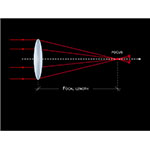The focal length or focal distance is the distance between the lens and the real or virtual focus. By convention, the focal length of a converging lens is indicated by a positive number, that of a diverging lens by a negative number.
Like lenses, mirrors can make rays converge or diverge. A concave mirror forms a real focus, a convex mirror forms a virtual one. In either case, the focal length is the distance between the mirror and the focus.
Focus and focal length can also be defined for a generic optical system comprising two or more elements (lenses or mirrors). To determine the focus and the focal length it is necessary to:
- examine a pair of incoming rays (for example, the outermost or marginal rays, toward the edges of the lens)
- identify the same rays as they leave the optical system
- extend the two emergent rays until they meet; the point of intersection is the focus, which can be real or virtual.
- extend, if necessary, the incoming rays and the corresponding emergent rays to find their points of intersection. This pair of points defines the position of the so-called equivalent lens (conventionally denoted by a double-arrow segment): the entire optical system behaves like a simple lens placed in that position. The focal length (or equivalent focal length) is the distance between the equivalent lens and the focus.
There are optical systems in which, if the incoming beam is made of parallel rays, the emergent rays are also parallel. In that case it is not possible to define the focus or the focal length, and the optical system is called afocal. Telescopes fall into this category.








